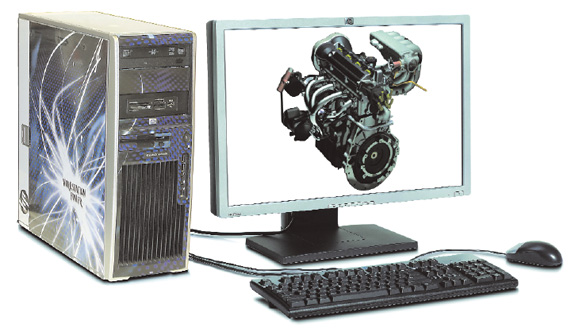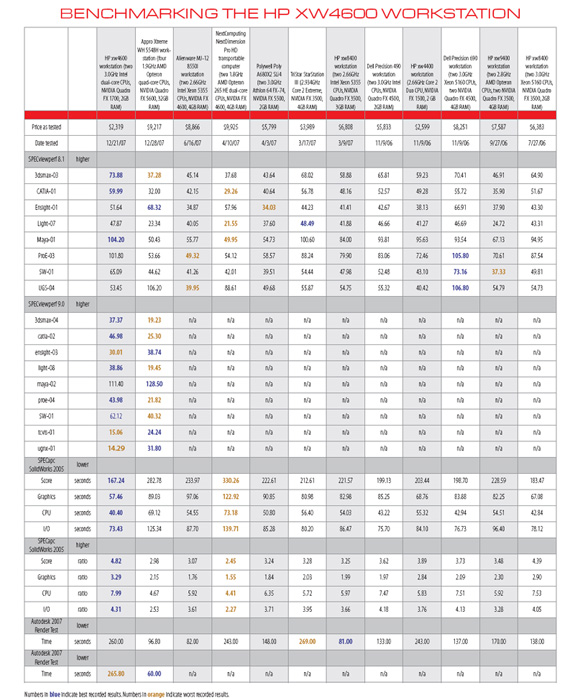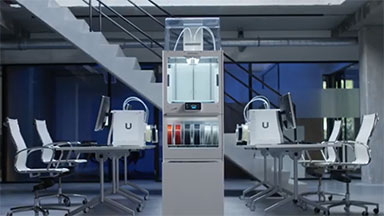HP’s New XW4600 Workstation: Another Winner
The latest version of HP's single-socket workstation, based on the new Intel X38 Express performance chipset, repeats perfection.
Latest News
December 4, 2001
By David Cohn
HP recently refreshed its entire line of workstations. As part of that refresh, the company announced its new xw4600 workstation, the successor to the xw4400 that DE reviewed last year. In that review (see “Perfect for MCAD” DE, February 2007), we stated that the xw4400 was a perfect choice for midrange CAD. So we were very curious to see what HP had to offer in its replacement.
 The HP xw4600 workstation breaks records forprice/performance. Our evaluation unit camewrapped in a custom color graphic skin. |
The HP xw4600 is the first workstation we’ve received based on the new Intel X38 Express performance chipset. This chipset includes a number of new features, including support for PCI Express 2.0, 45nm Intel Dual and Quad-Core processors, and dual x16 PCIe graphics slots. HP offers the xw4600 with CPU options ranging from a 2.0GHz Pentium Dual-Core up to the 3.0GHz Quad-Core Intel Core 2 Extreme.
Our evaluation unit arrived with Intel’s new 3.0GHz Core 2 Duo E6850 processor, and was housed in HP’s now familiar tool-less chassis. No tools are required to open or upgrade the workstation. But the system we received was a bit of a departure from past HP workstations. Instead of the typical black and gray minitower case, the computer we received came wrapped in a colorful graphic skin, courtesy of Skinit, Inc. HP now lets anyone give their system a custom appearance thanks to these vinyl skins that can be ordered directly from HP’s website. A full skin like ours, which covers the faceplate, sides, and top of the case, adds $77 to the cost of the system, while a skin on the faceplate only costs $30.
HP Workstation xw4600 >Price: $2,319 as tested; $1,775 until 4/30/2008 ($760 base price) |
While the appearance options will appeal to some users, it’s what’s inside that counts. As in most HP workstations, the xw4600’s front panel provides two USB 2.0 connectors, headphone and microphone jacks, and an optional FireWire connector. A third front panel USB jack came courtesy of the HP 16-in-1 card reader mounted in one of the three 5.25-inch front-panel drive bays. A second drive bay was filled with an HP 16X DVD+/-RW dual-layer optical drive with HP Lightscribe technology, while the single 3.5-inch bay contained a floppy drive. The rear panel adds six more USB connectors, a single 9-pin serial port (a second serial port is optional), a 25-pin parallel port, PS/2 keyboard and mouse ports, an RJ45 LAN connector for the integrated Broadcom 5755 NetXtreme Gigabit LAN, another FireWire connector, a SATA port, and audio-in, audio-out, and microphone jacks. Like other HP workstations, the sound system supports jack retasking, which allows t he computer to sense devices that are plugged into an audio jack.
Upon opening the case, we found the kind of clean, well-organized design we’ve come to expect from HP. The HP motherboard provides four DIMM sockets. Although the X38 chipset supports DDR3 memory, the xw4600 uses less-expensive DDR2 memory and supports up to 8GB when using 2GB 800MHz ECC DIMMs. Our evaluation unit came with 2GB installed as two 1GB modules. The motherboard also provides an integrated serial ATA controller with 5 SATA connectors, with RAID 0, 1, 5, and 10 capabilities.
The motherboard provides a total of seven full-length slots: two PCI-Express x16 graphics slots, a PCI-Express x8 slot (x4 electrically), a PCI-Express x1 slot, and three legacy PCI slots. One of the two graphics slots was filled with a new NVIDIA Quadro FX 1700 graphics accelerator with 512MB of DDR2 memory. This mid-range 3D board is based on the same unified architecture previously found on the Quadro FX 4600 and FX 5600 and is compatible with the new second-generation PCI-Express specification, which doubles the data transfer rate for an aggregate bandwidth of 16GBps bidirectional.
Our xw4600 also came with a 160GB 7200rpm Seagate Barracuda SATA hard drive. HP offers other drive options, including SATA drives with up to 500GB capacity. The system can accommodate up to four drives using an optional expander kit. The 475watt active Power Factor Correction power supply provides for all of the system’s expansion capabilities, yet the xw4600 meets the 80 PLUS and Energy Star certifications. And in spite of fans on the CPU heat sink, rear panel, power supply, and graphics card, the xw4600 is nearly silent.
Record-setting results
Of course, the proof of any system is in its performance, and here the HP xw4600 surpassed our expectations. On the SPECapc viewperf graphics benchmark, this new HP workstation scored some of the best results we’ve ever recorded, clearly showing the benefits of the new NVIDIA graphics card and second-generation PCIe speed improvement.
 |
But on the SPECapc SolidWorks benchmark, which is more of a real-world test (and breaks out graphics, CPU, and I/O performance separately from the overall score), the results were even more surprising. The HP xw4600 was fastest in every category, completing the test in just over 167 seconds, nearly 9 percent faster than the previous top performer (an HP xw8400 workstation costing nearly three times as much). It was only on our AutoCAD rendering test, which clearly shows the benefits of multiple CPU cores, that we saw the dual-core xw4600 lag behind other systems, taking more than four minutes to complete our test rendering (compared to one minute for the recently reviewed Appro Xtreme with the equivalent of 16 CPUs).
As usual, HP rounds out the xw4600 with its excellent 104-key keyboard and a 2-button optical scroll mouse. Windows XP Professional 32-bit came preinstalled. The 64-bit version of Windows or Red Hat Linux (32- or 64-bit), as well as Windows Vista are also available. Our Windows-based system also included the HP Performance Tuning Framework and is backed by a three-year warranty that includes parts, labor, and on-site service. And, like HP’s other systems, most CAD and DCC applications are tested and certified on the xw4600.
Perhaps even more surprising than the outstanding performance was HP’s aggressive pricing. The HP xw4600 workstation has a starting price of only $760, albeit based on a 2GHz dual-core, 1GB of RAM, an 80GB hard drive, and an NVIDIA Quadro NVS 290 graphics board.
But even as equipped, our evaluation unit costs just $2,319, and is available at the promotional price of just $1,775 through the end of April.
While systems supporting two or more CPUs and much more memory would clearly outperform the xw4600 when running more demanding applications such as FEA and CFD or working with very large datasets, the price/performance of the HP xw4600 makes it an absolutely perfect system for midrange CAD.
Contributing Editor David Cohn is a computer consultant and technical writer based in Bellingham,WA, and has been benchmarking PCs since 1984. He’s an applications engineer with The PPI Group, and the author of more than a dozen books. Please send comments about this article to [email protected]. You can also contact David at [email protected].
Subscribe to our FREE magazine, FREE email newsletters or both!
Latest News
About the Author
David Cohn is a consultant and technical writer based in Bellingham, WA, and has been benchmarking PCs since 1984. He is a Contributing Editor to Digital Engineering, the former senior content manager at 4D Technologies, and the author of more than a dozen books. Email at [email protected] or visit his website at www.dscohn.com.
Follow DE




